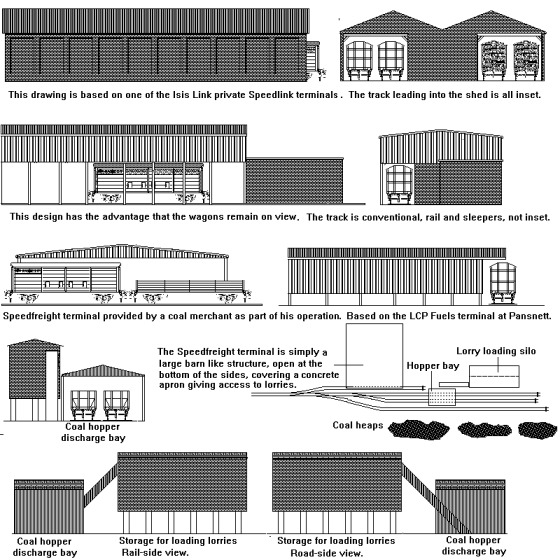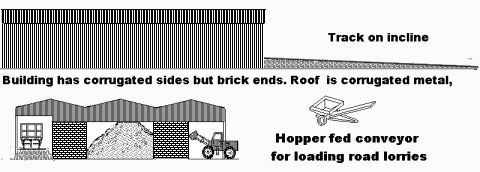The modern air braked Speedlink service made considerable use of rolling stock leased from third party suppliers, these were regularly re-painted in the hiring companies livery. These wagons usually ran between two sites owned by the same company or from a supplier to a user, both with private sidings. Continental sliding wall vans, first introduced for ferry services, were regularly used for internal UK traffic as they were well suited to handling the palletised loads that were becoming increasingly common. The ferry services also brought in a number of privately owned tank wagons carrying everything from chemicals to wine.
There were a small number of depots handling general goods, three examples are sketched below. The uppermost drawing shows the Isislink terminal in London, a fully enclosed brick walled building and a below that a depot where the tracks ran outside the building but under cover of a metal roof. The latter is preferable from a model railway point of view as it leaves the stock on show and allows wagons which fail to couple automatically to be retrieved. The lower drawing shows a simple terminal where a coal merchant had provided a concrete pad and simple barn type structure to allow lorries to get close to the wagons and vans for loading. The track in that example was outside the 'shed'. All tree examples would see BR owned vehicles, ferry vehicles (both PO and foreign railway company ferry stock) and British based PO vehicles (mostly vans). Tank wagons might also be dealt with at such terminals.
Fig ___ Private Speedlink Depots

Following a fall off in traffic in the early 1970's the rail movement of grain in the UK was revamped by a shipping company called Traffic Services Limited, or TSL. They set up a system called Grainflow and undertook to handle all dealings with BR on behalf of the shipper. Grainflow wagons were painted in overall green livery with yellow lettering and travelled in Speedlink trains. The N Gauge Society offer a neat etched brass kit of the large bogie 'polybulk' wagons used for this service which includes a set of transfers. Also the Peco 'Grano' wagons and Ibertren grain wagons would serve for this traffic but the lettering would be difficult (see Fig ___). The Speedlink wagonload service was discontinued in 1991, the Grainflow operation continued for a time working as block train loads but this proved not to be viable and the service ceased operating in 1992.
In the early 1970's there was a sudden increase in demand for crushed stone for buildings and roads and new terminals were opened close by quarries. Initially BR carried the stone in a fleet of old vacuum braked tippler wagons these were still in occasional use through to the end of the 1980's. By the late 1970's the Procor designed PGA hopper had arrived (as available from Graham Farish who offer the open and closed versions in their range). By the mid 1980's new designs of tippler wagon were in service, including refurbished 102 GLW ex British Steel bogie iron ore tipplers. The heaviest train ever pulled on British lines was an ARC road stone train made up of 43 Procor ex-British Steel 102 ton GLW tippler wagons.
The hopper wagons feed established distribution points where they are unloaded through a `drop' into open air bays where mechanical shovels or conveyor belt systems transfer the stone to stockpiles or into road vehicles for local distribution. The tippler wagons are commonly used to supply new or temporary railheads where they are unloaded by cranes equipped with grabs. The ex British Steel wagons had a rotating coupling which allowed the wagon to be turned upside down in a specially designed cage whist still coupled up. Procor initially leased the wagons to Foster Yeoman and later to other stone firms. I believe that at least one stone depot was equipped with a suitable rotary tippler for these wagons. The wagons were pushed into the raised building via an inclined track (so the loco did not pass through the tippler) and heavy mechanical shovels then transferred the stone to the nearby stockpiles. The sketch below shows the general arrangement, taken from a photograph. The piles of stone could be seen through the large openings in the end of the building but the mechanism for emptying the wagons could not be seen.
Fig___ Tippler equipped stone terminal

In 1988 a new type of wagon for crushed stone was unveiled having a hopper type body but with a conveyor system under each wagon. The conveyors are extended to form a continuous path and at the discharge point they are coupled to a bogie wagon fitted with a swivelling conveyor arm. This allows a simple siding with no additional facilities to be used as a crushed stone delivery point. The wagons are coupled in semi-permanent rakes of ten and TOPS coded as PHA (note some were incorrectly branded PGA), they were designed and built by the Standard Wagon Co (subsequently called Powell Dufryn Standard) and the first user was Redland.
There were, and are, a number of PO container wagons carrying specialised containers for materials such as gypsum. These are more fully discussed in the section on Unit Loads - Modern Containers, Road Railer, Piggyback and Swap Bodies.